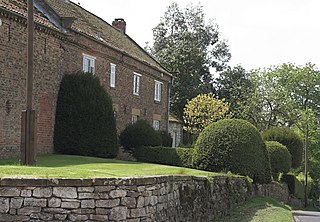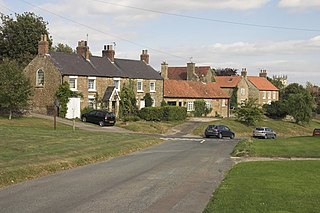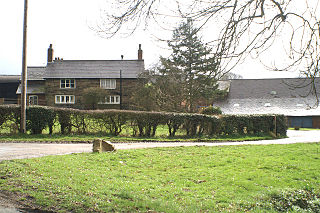
Barton-le-Street is a village and civil parish in North Yorkshire, England. According to the 2001 census the parish had a population of 186 reducing to 170 at the 2011 Census. It is located about five miles west of Malton, between Appleton-le-Street and Slingsby on the old Roman road which is now the B1257.

Barugh (Great and Little) is a civil parish in North Yorkshire, England, covering Great Barugh and Little Barugh. Great Barugh is located at a junction on the road between Malton and Kirkbymoorside. Barugh is about 15 miles (24 km) west of Scarborough.

Manfield is a village and civil parish in the Richmondshire district of North Yorkshire, England. It is a parish in the wapentake of Gilling East. The closest major town is Darlington, which is 3.5 miles (5.6 km) east of Manfield. It is close to the River Tees and Darlington and is notable for its real ale pub, The Crown, which won the Campaign for Real Ale (CAMRA)'s Yorkshire Pub of the Year in 2005, the All Saints Church and Manfield Village School.

Slingsby is a village and civil parish in North Yorkshire, England. It is about 6 miles (10 km) west of Malton on the B1257 road. According to the 2001 Census had a population of 634, increasing to 665 at the 2011 Census.

Scotton is a village, civil parish and electoral ward in the Richmondshire district of North Yorkshire, England. The civil parish includes the centre and south of Catterick Garrison. The village lies in the south of the civil parish, and is effectively a suburb of Catterick Garrison. The village of Scotton is located 3+1⁄4 miles south west of Catterick village.

Bridekirk is a village and civil parish in the Cumberland district in the county of Cumbria, England. It is around 3.2 kilometres (2 mi) north of the Derwent river and about the same distance from the nearest large town of Cockermouth just south of the river. Bridekirk is just outside the Lake District National Park and is not far from the Maryport and Carlisle Railway.
Nether Silton is a village and civil parish in the Hambleton District of North Yorkshire, England. It lies 6 miles (9.7 km) east of Northallerton, on the border of the North York Moors national park. During 1870–72 Nether Silton was described as, "a chapelry in Leake parish, N. R. Yorkshire; 6½ miles E of Northallerton r. station. Post town, Thirsk. Real property, £1,702. Pop. 178. Houses, 45." by John Marius Wilson, Imperial Gazetteer of England and Wales.

Leathley is a village and civil parish in the Harrogate district of North Yorkshire, England, the parish includes the townships of both Castley and Leathley. It is near the border with West Yorkshire and the River Wharfe, 1 mile north-east of Otley. The B6161 runs through the village, connecting Leathley with Killinghall in the North and Pool-in-Wharfedale in the south.

Terrington is a large village and civil parish in the Ryedale district of North Yorkshire, England. It is situated in the Howardian Hills, 4 miles (6.4 km) west of Malton.

Harome is a small village and civil parish in the Ryedale district of North Yorkshire, England, around 2 miles (3.2 km) south-east of the market town of Helmsley, and 24 miles (39 km) north-east of York. The village has a population of 261 people according to the 2011 UK census, and a total land area of 9,539 sq metres. It is situated to the east of the River Riccal. The village has 109 households, with agriculture and retail trade being the two main employers for the residents. The name Harome simply means rocks/stones, and translates from old English meaning a heap of stones.

Appleton-le-Street is a small village and in the Ryedale district of North Yorkshire, England. It is approximately 3 miles (5 km) west of Malton and in the parish of Appleton-le-Street with Easthorpe.

Thorpe Bassett is a village and civil parish in North Yorkshire, England. It is located between York and Scarborough in the North East of England. Surrounded by farmland the small village is home to 105 residents at the 2011 census. An increase of 4 since the 2001 census.

Ryton is a village and civil parish in Shropshire, England, in the district of Bridgnorth. It lies about one mile north north west of Beckbury. The civil parish originates during Norman times, and appears as "Ruitone" in the Domesday book of 1086. Ryton was part of the Saxon parish of Shifnal, but became separate at some point during the 12th century because there is mention of a priest at Ryton named Bernard in 1186.

Stansfield is a village and civil parish in the West Suffolk district of Suffolk in eastern England. Located seven miles south-west of Bury St Edmunds, in 2011 its population was 221. The village has an Anglican church dedicated to All Saints. In 1870, John Marius Wilson's Imperial Gazetteer of England and Wales described Stansfield as

Ousden is a village and civil parish in the West Suffolk district of Suffolk in eastern England. It is located around six miles west of Bury St Edmunds and 72 miles north of London, and as of 2011, its population is 266. The village has an Anglican church of St Peter's and a chapel in the cemetery dedicated to St Barnabas.

Millington is a former civil parish, now in the parishes of Millington and Rostherne and Little Bollington with Agden, in the Cheshire East district, in the ceremonial county of Cheshire, England. The parish was 8 miles (13 km) from Warrington and 3 miles (5 km) from Altrincham. Its name is a "relic of Saxon clanship – the ton or town of the Millings". The parish is primarily agricultural, with a number of farms including Moss House Farm, Newhall Farm, Mereside Farm, Boothbank Farm and Stonedelph Farm. Millington has been recently described on Britain Streets as a "hamlet or isolated settlement in the inhabited countryside". Millington is situated within the market town Macclesfield. The M56 motorway was close to the parish, which allows travel into areas of Warrington and Manchester, 13 miles (21 km) and 14 miles (23 km) away respectively. In 2011 the parish had a population of 234.

Eyke is a village and a civil parish in the East Suffolk district, in the English county of Suffolk. It is located on the A1152 road near the town of Woodbridge. Eyke has a primary school, the manor house of Lord and Lady Lucas with scenic pond and horse paddock, and a pub. The mediaeval parish church of All Saints was restored in the 1860s. Services are normally held on the first and third Sundays of the month.

Huntingfield is a village near the B1117 road, in the East Suffolk district, in the county of Suffolk, England. The village is close to the source of the River Blyth and the parish is 12 miles from the seaside town of Southwold. Nearby settlements include the town of Halesworth and the villages of Walpole, Heveningham, Cookley and Laxfield.
Hildenley is a former civil parish 2 miles (3.2 km) south-west of Malton, North Yorkshire, England, on the north bank of the River Derwent. In 1961 the parish had a population of 17. Hildenley stone, considered to be the best decorative stone in Yorkshire, takes its name from the site.

Norbury is a small village and civil parish in Shropshire, England. It lies to the west of the Long Mynd and the nearest town is Bishop's Castle. The parish is made up of three townships Asterton, Whitcott and Hardwick. There is a parish church dedicated to All Saints and a Country House B&B called The Coach House.

























